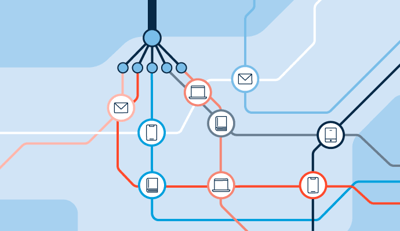June 23, 2025
 by Alyssa Towns / June 23, 2025
by Alyssa Towns / June 23, 2025

Ever added something to your Amazon cart on your phone, then finished the purchase on your laptop or by asking Alexa?
That’s not a coincidence. It’s omnichannel marketing at work. So, what is omnichannel marketing in e-commerce, and why is it so effective across devices?
Omnichannel marketing is a strategy that integrates all customer touchpoints, both online and offline, into a seamless brand experience. It unifies channels like email, social media, websites, mobile apps, and physical stores to provide consistent messaging and interaction across the entire customer journey.
Amazon sets the gold standard. From personalized recommendations and one-click checkout to cross-device order tracking and voice shopping via Alexa, every experience feels connected. Even in physical spaces like Amazon Go and Whole Foods, app-based payments, purchase history, and Prime discounts extend the same convenience.
This isn’t just about being present on every channel. It’s about making customers feel recognized and valued, no matter how they interact with your brand. To pull this off, companies need a smart strategy, journey mapping, and the right omnichannel marketing software.
Omnichannel commerce platforms help centralize product data, coordinate campaigns, and maintain consistency across channels, so brands can deliver smooth, uninterrupted buying experiences at scale.
Many brands wonder: Should we use a multichannel or omnichannel approach to improve customer experience? While the terms are often used interchangeably, they represent two different strategies with distinct goals.
If you’re caught up on your Latin, you know that omni means “all” and multi means “many” and that small difference says a lot. Even so, omnichannel and multichannel are sometimes used synonymously, but they’re different strategies with distinct goals.
| Feature | Omnichannel marketing | Multichannel marketing |
| Approach | Customer-centric | Channel-centric |
| Channel integration | Channels are fully integrated | Channels operate in silos |
| Consistency of brand experience | Context-aware and personalized across touchpoints | Often tailored per channel, but not connected |
| Message personalization | Continuous and connected experience across devices and platforms | Disjointed requires customers to re-engage at each channel |
| Data flow | Centralized | Fragmented |
| Strategy goal | Enhance customer experience through cohesion | Maximize reach across different channels |
| Example | A customer clicks a product ad on Instagram, gets a follow-up email about it, and can check out later on the app or in-store, all synced | A new product launch with campaigns on different channels. |
A multichannel marketing strategy helps businesses interact with customers through a lot of independent channels. Each channel – brick-and-mortar stores, websites, social media pages, apps, text messages, emails – operates independently. This means that although customers can interact with any of these channels, the encounters may not be cohesive from one channel to the next. Brands might also use strategies and messaging to target consumers. In a multichannel strategy, the siloed separation between channels is intentional.
Omnichannel strategies are customer-centric and utilize multiple channels to provide a seamless and connected customer experience. Omnichannel marketing creates an integrated customer journey as leads move through the buying journey between online and offline channels. A holistic experience marks the cornerstone of an omnichannel strategy. It answers the question many marketers ask: how do you create a seamless customer experience across channels like apps, social media, and stores?
Now that we’ve defined the difference, let’s look at why omnichannel strategies are worth the investment.
An omnichannel marketing approach offers many undeniable benefits to businesses and their customers.
An effective omnichannel strategy allows businesses to reach customers wherever they are to lengthen their reach and lead customers along the path to purchase. Forbes described this experience well, noting, “Whether they’re using their smartphone in your store, opening their inbox or browsing social media, your messages get seen.”
A customer can take many routes when considering spending their money on your business. For example, a customer’s path to purchase might include:
With so many different touchpoints involved, customers feel frustrated when the experience is inconsistent or disconnected. They may decide not to complete their purchase or determine that looking elsewhere is less hassle. Omnichannel marketing supports them throughout their buying journey and makes certain that the handoffs between channels are seamless and that each experience is integrated and consistent from start to finish.
Omnichannel marketing strategies create more engaging customer experiences and convert more prospects into loyal customers. According to Loyal Guru, retailers with strong omnichannel marketing capabilities retain 89% of their customers, compared to a 33% retention rate for companies with deficient omnichannel strategies.
Omnichannel loyalty programs play a significant role in this advantage. Consider the Starbucks Rewards app: users can order ahead, pay in-app, track points, and earn free drinks. Every interaction adds value, which builds stickiness and habitual engagement. The easy buying experience, paired with the appeal of free chai lattes, encourages guests to return time after time.
When all your channels are integrated, your data is too. That means you can track customer behavior holistically, not in silos. You’ll understand what drives conversions, where users drop off, and how each touchpoint contributes to revenue. This lets teams deliver more relevant campaigns, reduce wasted spend, and optimize the entire marketing funnel.
For example, if someone clicks a product ad on Instagram but abandons checkout, your CRM can trigger a personalized email or push notification, without missing a beat.
Developing an omnichannel marketing strategy requires time, strategic planning, and understanding. Remember, personalization techniques and an integrated customer journey are critical elements of your omnichannel marketing strategy.
If you aren’t sure how to get started, here’s how to create a strategy that actually works..
It’s difficult to create an effective omnichannel marketing strategy unless you know who your audience is and where to reach them. Since the omnichannel experience centers on customers, a poor or misaligned understanding of your base could lead to an ineffective omnichannel strategy.
So, who are your customers? Through research, market analysis, interviews, previous purchase information, and social listening, you can create buyer personas – fictional profiles of your ideal customers. You might have already defined these or maybe have an idea of what they’ll look like. You could have two personas or ten! It depends on the nature of your company.
These personas should reflect both demographics and behaviors: Are they mobile-first? Do they research online but buy in-store? The more accurate your picture, the more personalized and relevant your strategy will be.
Next, with your buyer personas in mind, identify the touchpoints customers navigate throughout their buying journey, from pre-purchase to post-purchase. Every touchpoint counts, so you must document every one of them to locate gaps in the journey that an omnichannel experience may fill in.
To do this, start by aggregating as much data as possible, including online and offline experiences and step-by-step actions that lead to sales. Analyze customer behavior, gather social listening data, and pull data about previous purchasers through analytics and other tools for a complete picture of the customer path. Include the stages, touchpoints, emotions, and gaps in the current state.
Consider buyers’ pain points and ask yourself the following questions:
With your current context, you can now spend time mapping an omnichannel customer journey for each of your buyer personas. Use their preferred channels to complete each stage of the buyer’s journey and consider how you might make those touchpoints personalized.
You might add an additional touchpoint, like an app that connects the journey holistically from start to finish. Or you might realize there’s a gap between your social media profiles and your website that you have to address to ensure consistency. Whatever the case, detail a plan of what you want the customer experience to feel like and what you need to achieve the plan.
Omnichannel strategies succeed when messaging and branding stay consistent across all channels. It’s easy to inadvertently disrupt the customer journey with unclear messaging across platforms. That’s not to say you can't vary the look and feel of your content, but a reader needs to understand that the sale they received an email about is the same one they see on your website a few hours later.
A clear brand style guide, including the brand’s visual identity, style, and tone, sets the stage for creating consistent content across channels. Brands should generate content that matches the buyer’s position on their journey. For example, promoting a “final chance to buy” message on Instagram doesn't make sense if that isn’t the touchpoint where most customers convert.
Brands usually have to experiment to find what works best. Let’s explore an example from Biossance.They shared a text, sent an email, and updated their homepage with similar messaging.
The text message:
The email:
The website:
Potential customers can easily tell that they’re looking at the same campaign across all touchpoints and don’t have to dig to find the 25% discount. Flawless!
Omnichannel isn’t just a marketing project. It’s a company-wide initiative. Make sure marketing, sales, support, and operations teams work from the same customer data and understand the shared goals.
Tools like your CRM, CDP, and automation platform should be integrated to reflect real-time customer behavior across systems. Cross-functional alignment ensures your internal processes are as seamless as the experience you want to deliver externally.
Even the best strategy will evolve. Use customer feedback, behavior data, and campaign performance to continuously refine your journey.
Run A/B tests, review analytics, and stay flexible as customer expectations change. Omnichannel is an ongoing practice, not a one-time setup.
Keep your customers at the forefront of your omnichannel marketing strategy by gathering feedback, tracking performance metrics, and using this information to understand where you can improve. As your customers change over time, your omnichannel strategy should follow.
Once your strategy is in motion, it’s important to track what’s working and where to improve. These key metrics help you measure both customer engagement and operational efficiency:
| Metric | Why it matters |
| Customer retention rate | Indicates how well your experience keeps customers coming back |
| Average order value (AOV) | Reflects whether a unified journey encourages higher spending |
| Conversion rate by channel | Reveals which combos drive sales |
| Net promoter score | Measures customer satisfaction post-journey |
| Time to resolution | Tracks CX efficiency via support touchpoints |
| Cross-channel attribution | Tracks how different touchpoints contribute to conversions |
| Repeat purchase rate | Measures loyalty and lifecycle value |
To get the most out of these KPIs, assign clear owners across teams, align each metric with business goals, and review performance regularly in cross-functional planning meetings.
To deliver a seamless omnichannel experience, your technology must be just as connected as your customer journey. That means investing in tools that not only function independently but also talk to each other in real time. Here are the core components of an effective omnichannel tech stack:
A CRM system serves as your central customer database, storing information like purchase history, communication preferences, and support interactions. It gives every team, be it sales, marketing, or customer service, access to a unified customer profile. Your shoppers’ purchase history, queries, and reward activity are always up to date,whether they’re browsing the app or visiting a physical store on the CRM.
Why it matters: Without a centralized CRM, communication becomes fragmented and efforts are often duplicated across departments.
A CDP collects and unifies customer data from multiple sources, such as your website, app, physical store, and social channels, into a single, real-time profile. It enables deep personalization and consistent messaging across touchpoints.
Why it matters: CDPs allow you to tailor campaigns based on customer behavior and preferences, not just broad segments.
AI-powered chat tools provide 24/7 customer support, handle frequently asked questions, and assist with purchases across websites, apps, and messaging platforms.
Why it matters: These tools ensure continuous, responsive service and reduce customer friction, especially outside business hours.
Modern POS systems do more than process payments. They integrate inventory management, loyalty data, and customer profiles across both digital and physical channels.
Why it matters: A connected POS system enables services like buy online, return in-store (BORIS), and real-time inventory visibility across all locations.
A centralized loyalty system tracks points and incentives across channels, allowing customers to earn and redeem rewards seamlessly whether they’re shopping online, in an app, or in-store.
Why it matters: Consistent loyalty experiences increase customers' likelihood of staying engaged and making repeat purchases.
Marketing automation platforms power behavior-based messages, such as emails, SMS campaigns, and push notifications triggered by specific actions like cart abandonment or browsing history.
Why it matters: Automation enables timely, relevant engagement at scale and helps move customers through the funnel efficiently.
Even the best tools can’t deliver a seamless experience if they don’t communicate. APIs, native integrations, or middleware platforms ensure smooth data exchange between systems.
Why it matters: Eliminating data silos is essential for real-time personalization and unified customer experiences.
When the right tools work together behind the scenes, the result is a customer journey that feels effortless, from first click to final purchase.
You’ve got the strategy. You’ve got the tools. But even with the right tech stack and a mapped-out customer journey, your omnichannel efforts can fall flat if key execution gaps go unchecked. Before we dive into brands doing it right, here are some common mistakes that can quietly undermine even the best omnichannel intentions:
It’s one thing to have a CRM, a CDP, and a loyalty platform. It’s another to make them talk to each other. When customer data is fragmented across platforms, teams lose visibility, and the experience loses cohesion.
How to fix it: We mentioned this before. Use a centralized CDP and ensure all tools can communicate via APIs to maintain real-time customer profiles. Make integration a priority, not an afterthought. APIs, middleware, and real-time data syncing tools should be the backbone of your stack.
If your email says one thing, your website another, and your social ads something completely different, that's not omnichannel. That's confusion. Customers lose trust fast. Inconsistent language, visuals, or offers disrupt the journey and confuse buyers.
How to fix it: Create a cross-channel content calendar with shared campaign briefs and use a brand style guide to keep tone, messaging, and visuals aligned.
Many brands focus heavily on digital channels and overlook in-store or call center interactions. Omnichannel means all channels, including brick-and-mortar stores and face-to-face moments, should be connected and accounted for.
How to fix it: Sync POS systems, in-store data, and loyalty programs with digital tools so offline activity informs online experiences and vice versa.
Even the best tools can’t fix poor collaboration. When marketing, sales, and support teams operate independently, customers experience friction. A campaign might promise one thing, while the service team delivers another, or isn't even aware of the campaign at all.
How to fix it: Align teams around shared KPIs, unify data access, and hold regular cross-functional planning sessions to ensure a connected strategy.
Omnichannel success isn’t just about the stack. It’s about how well your people, processes, and platforms work together. Keep these pitfalls in check, and you’ll be ready to build a truly connected customer experience.
Strategy and software are only part of the equation. Avoiding execution pitfalls is just as important. But what does omnichannel success actually look like in practice?
Let’s look at how top brands put these strategies into action, using the right tools, avoiding silos, and delivering seamless experiences that keep customers coming back.
The Starbucks Rewards app is one of the most praised omnichannel experiences in the retail space. Customers can browse the menu, place an order ahead, earn rewards, and pick up their drink, all without breaking stride.

Why it works: Starbucks uses tech to make routine purchases feel personalized and effortless, encouraging repeat visits.
Recreational Equipment, Inc. (REI) provides quality gear, apparel, and rental equipment for outdoor adventures. Customers can shop REI online or take advantage of their services and expert advice at one of their stores.
Members who join the REI Co-op membership earn rewards, receive coupons, and get free standard shipping in the US, among many other exclusive benefits. A few weeks ago, many of REI’s customers received 20% off coupons with a sneak peek of early access deals for members only. On the back of the mailer, the company listed the addresses of local REI stores. Customers can also open the REI app, see a reminder about the member coupons, view available stock via the app, coordinate curbside pick-up, or have items shipped for free.
REI does a fantastic job of ensuring that its channels work together to create a great customer experience, especially for Co-op members.
Why it works: REI blends digital convenience with physical service and real-time inventory transparency.
Source: REI
IKEA, Sweden’s home furnishings brand known for affordability and design across the globe, does excellent omnichannel marketing. In an interview with Google, the chief digital officer for Denmark, Karen Helweg, and the country marketing manager for Belgium, Grégory Bauduin, discussed their success.
They highlighted that customers love the IKEA experience, which almost always involves a half-day of exploring the store and stopping at the food court for meatballs. To build on the in-person shopping experience and provide customers with more control, IKEA prioritized the following:
Read more about IKEA’s omnichannel ecosystem in Atcom’s case study.
Why it works: IKEA removes friction from its famously hands-on experience by supporting each stage of the journey digitally.
Source: IKEA
As customer expectations rise and digital ecosystems become more complex, omnichannel marketing is shifting from a nice-to-have to a core business capability. Here are the trends redefining how leading brands approach omnichannel today:
Omnichannel marketing is moving beyond basic audience segments like “new vs. returning customer.” Today, AI and automation tools help brands respond to each individual's actions in real time. That means adjusting product recommendations, content, offers, or timing based on a customer’s recent behavior, whether they just browsed a product, opened an email, or left an item in their cart.
This trend reflects a growing need to answer: how do brands personalize omnichannel experiences in real time?
Instead of relying on manual triggers or fixed schedules, these tools learn from customer actions across channels and deliver the most relevant message or experience automatically. It’s personalization that adapts to the moment, not just the persona.
Marketers are investing in unified customer profiles that persist across devices, sessions, and environments. This enables continuity, whether a user browses anonymously on mobile, logs in on desktop, or visits a store, their preferences, history, and status carry over seamlessly. Persistent identities are fast becoming the backbone of effective omnichannel orchestration.
The focus is shifting from just “being everywhere” to enabling fluid movement between channels. Customers increasingly interact with multiple touchpoints within a single transaction, comparing reviews on mobile while in-store or browsing on desktop while chatting with a support bot. Omnichannel strategies now account for simultaneous, not just sequential, interactions.
As regulations tighten and cookies disappear, marketers are pivoting to first-party and zero-party data strategies. Omnichannel programs now emphasize consent-driven data collection through loyalty programs, post-purchase surveys, and gated content. Brands are rethinking personalization in ways that protect privacy while still enhancing relevance.
Retailers are blending immersive technologies like AR, live video, and virtual consultations directly into their omnichannel ecosystems. These experiences are no longer siloed campaigns. They’re built into ecommerce platforms, mobile apps, and even store layouts, enabling discovery, engagement, and purchase to happen on the customer’s terms.
Omnichannel success now depends less on marketing alone and more on organizational alignment. Leading companies are aligning marketing, product, customer support, and operations around shared KPIs like lifetime value, resolution time, and loyalty engagement. Tech stack integration is no longer optional—it’s a company-wide discipline supported by process and leadership.
Omnichannel marketing experiences enhance the customer journey by providing an integrated experience across all channels, no matter how many a brand uses. Brands have turned to omnichannel marketing to expand their reach, engage customers through a seamless journey, and turn potential customers into loyal, lifelong fans. To do this effectively, you need to know who your customers are, where you can improve your current journey, and how to create cohesive, omnichannel content that customers love.
Level up your customer support touchpoints with a chatbot as part of your omnichannel strategy. Learn how to build a chatbot from scratch.
The article was originally published in 2024. It has been updated with new information.
Alyssa Towns works in communications and change management and is a freelance writer for G2. She mainly writes SaaS, productivity, and career-adjacent content. In her spare time, Alyssa is either enjoying a new restaurant with her husband, playing with her Bengal cats Yeti and Yowie, adventuring outdoors, or reading a book from her TBR list.
For most marketing and growth teams, customer acquisition is the top priority. You spend time...
 by Soundarya Jayaraman
by Soundarya Jayaraman
Consistency is the key to everything.
.jpg) by Aayushi Sanghavi
by Aayushi Sanghavi
If there's one thing working in marketing has taught me, it's that keeping existing customers...
 by Harshita Tewari
by Harshita Tewari
For most marketing and growth teams, customer acquisition is the top priority. You spend time...
 by Soundarya Jayaraman
by Soundarya Jayaraman
Consistency is the key to everything.
.jpg) by Aayushi Sanghavi
by Aayushi Sanghavi


